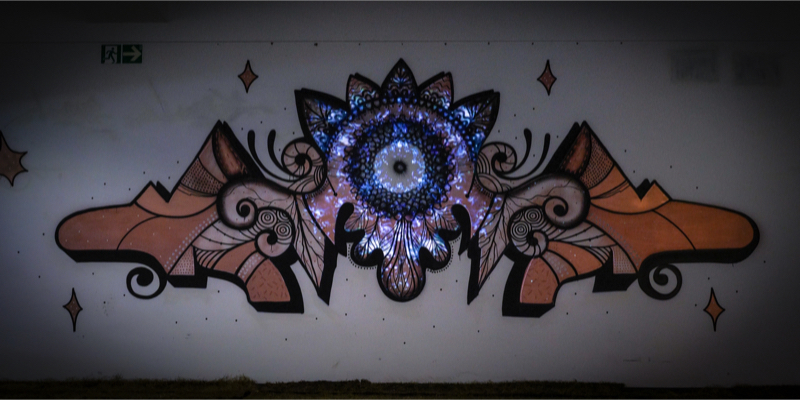Street art, also known as “graffiti,” has a history dating way back to the Stone Age, but really started to become a worldwide phenomenon in 1949–with the invention of the aerosol spray can. Fast forward to the early 90’s when twenty-something, Philipp Frank, started to discover his passion for graffiti writing. Little did he know, his affinity would eventually lead to a full-fledged, successful street art career (with a twist).
Philipp’s artwork evolved over the years from paint to a different medium. He developed skills in various artistic disciplines, eventually combining them to create mesmerizing, visually enchanting pieces. We are huge fans of his work, which uses light installation, projection mapping artwork, motion design, and cinemagraph production.
“Being creative is a basic need in my life. Whether it‘s working with paint, camera or pencil; on a computer, wall or canvas, creating makes me happy. I like the variety that different mediums can offer, and use whatever serves the idea best.”
We were so excited to be able to ask Phillip a few questions about what inspired him to combine art and engineering!
Tell us about a project you’re excited about right now—yours or someone else’s.
So many exciting projects all over the world. From the development of digital museums to immersive interactive experiences and AR. A great time to be alive and witness this ongoing merging of arts and technology.
Particularly, I am excited about my recently released “Elements“ short film. This was on my bucket list for many years. An audiovisual journey exploring five elements: air, earth, water, fire, and ether. I recorded a lot of corresponding footage along a river such as water, leaves, rocks, people making fire, and so on. Transformed it digitally into mesmerizing animations and re-projected them back onto the same nature objects. Creating a mix of something real becoming virtual and than real again. A real virtuality.
What motivated you to be an artist who also practices engineering? Did the education system nurture that interest, or did you have to take matters into your own hands?
My father was an engineer and always brought some technical stuff home. At the same time, he was doing a lot of photography and watercolour painting. I guess this can be considered my basic inspiration.
I was mainly interested in analog painting and filming. My brother worked in the projection mapping industry and one day we did an experimental project together. This was the main trigger when I became aware of the possibilities. Since then, I keep integrating all sorts of modern technology into my artistic process. It offers so many new ways of expressions never been done before. More or less unknown territory if you want, and this is only the beginning.
The school system did not encourage this process at all. But I also grew up in a time without internet or any mobile devices.
How do you use technology in your work? How do you want to be using technology 10 years from now?
Technology is involved in the whole process of creation. For me, it’s important to start with hand-drawn sketches. It’s a fast way to explore different options. On the computer, I will work out the project and add all 3D, video, and animation content. In fact, a lot would not have been possible without fast computers, bright beamers, and VR equipment.
But, most of my work is a mix of digital and analogue techniques. For example, to bring a mural painting with the help of 3D projection mapping to life, the painting itself would be nice. A projection mapping likewise. But the combination creates a whole new experience. Currently, I am working on making things more interactive to give visitors the chance to engage themselves and become part of the art.
Hopefully in 10 years we will be able to control computers in a much faster and intuitive way. Maybe by language, thoughts, or with contact lenses. Today, it is still a pretty slow and very time consuming process.
But with that fast technological development I think it is equally necessary to keep up with the development of our conscious minds. Modern technology requires a lot of responsibility towards our planet and the survival of the human race.
You get to have one conversation with your teenage self. What advice do you give him?
Haha, yes that’s good. I guess I would say: there are no errors, only experiences and learnings. So don’t think too much, just do it.
How important is collaboration to your work? Who have you collaborated with recently?
Collaborations are very important for the artistic and self development. Bouncing ideas back and forth with someone else will grow a project very fast and raise its quality. It’s always inspiring to get insights into the ways of thinking from someone that is an expert in his/her field.
My most recent collaboration was with sound designer Philipp Kampmann. He developed the music for the “Elements“ short film.
See more of what Philipp is up to and stay up to-date-on new projects by following him on Instagram: @philippfrank_art.









